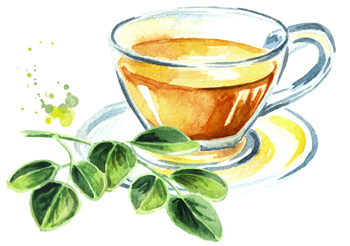Moringa Tea Contains Medicinal Properties To Improve Immunity Level Besides Treating Inflammation and Acute Malnutrition
How many times have you ignored "Moringa Tea" in your local superstore while considering it as another herbal tea with inflated claims for medicinal properties?
But it is not any other herbal tea on the shelf!
The natural products and organic plant derivatives have been proving their importance in the treatment of various ailments for centuries. The spread of word through the internet and social media has positioned plant based products as a primary component in alternative care therapies. The rising global demand for organic foods and herbal products have been inviting the researchers to develop new methods of extraction and product conversion of functional herbs. The dietitians and nutritionists have been focusing more on medicinal properties of natural plant based products.

Moringa oleifera has been proved by different research to have various health benefits to man. With a plethora of abundant bioactive constituents, derivatives of this plant exhibit anti-cancer, anti-diabetic, and lipid-lowering properties, affirming its importance in the medical war against both acute and chronic disease conditions.
An important derivative of the Moringa tree, gaining more popularity and use in the supplement market, is the Moringa tea. Herbal tea products are obtained from the parent plant by crude or standard methods of maceration or infusion in the water at different temperatures. Plant parts, including roots, bark, stem, leaf, seeds, and flowers, are of use in herbal tea production, with the bioactive compounds extracted through a skilled method of different factor variations.
Production of Moringa Tea
The general practice for the extraction of herbal tea involves a step/wise procedure of Moringa leaves processing, extraction, filtrate purification and concentration, moisture extraction, and product packaging. In essence, product branding ideas, such as color, particle size, and flavors are incorporated by varying production parameters such as extraction temperature, solvent ratio, and product pH
To aid local production of the Moringa tea, a study conducted by a team of expert researchers described an optimized method of extracting the Moringa tea from its powder extracted in distilled water. This method of production, as reported by the “Journal of Nutrition and Food Sciences,” involves the extraction of freshly prepared, Moringa oleifera powders by infusion method, with the use of a variable temperature controlled water bath and distilled water.
The resulting freshly brewed tea contains a rich mixture of bioactive polyphenols, tannins, and flavonoids responsible for exhibiting the different medicinal properties of the parent plant.
The “Journal of Nutrition and Food Sciences” published an innovative method of extracting samples of Moringa tea with an improved level of polyphenol concentration. However, this method is a model for skilled industrial procedures, with a possibility of optimization for local production in the future.
Moringa Tea Benefits
Improves Immunity Level
Our immune system is a network of biological systems, processes, and organs (including thymus, lymph nodes, and bone marrow) that defends the body against the invasion of harmful micro-organisms. A compromised immune system makes the body susceptible to diseases of different nature. Until the advent of ethnomedicine, the available immune boosters are biosynthetic drugs with variable side effects.
Organic Antioxidant activity
The excessive generation of reactive radicals is the cause of many human degenerative diseases. These radicals initiate a chain of reactions that ultimately damage the cell structure and cause cell death. The antioxidant properties of Moringa tea benefits are confirmed by phytochemical analysis of sample extracts to validate the presence of antioxidant phenolic constituents.
Phenolic compounds in Moringa tea extracts break the reaction chain caused by the generated free radicals and subsequently reverse cell damage. Antioxidative components in the tea extract include flavonoids, thiocarbamates, glucosinolates, and isothiocyanates.
With a superior antioxidant property compared to other plant derivatives, Moringa tea is a potential therapy method in the management of diseases free radical-induced conditions including Parkinson’s disease, Alzheimer’s disease, vitiligo, Lafora disease, and cancer.
Simply put, regular consumption of adequate potions of Moringa tea in the diet plan protects the body against oxidative damage.
Protects against Inflammatory Reactions
Inflammation is the typical body reaction to infections, injury, toxins, and invasion of the biological system by micro/organisms. The affected cells are damaged, leading to a secretion of various chemicals that cause cell disruption and leakage of the cell content into the surrounding tissues. Moringa tea has been suggested to contain phytochemicals that inhibit the body responds to inflammation. A study reported by the “American Journal of Immunology” validates the anti-inflammatory properties of Moringa tea on the liver cells after deliberate exposure to dust and inflammation inducing chemicals. The anti-inflammatory property of Moringa tea makes it a potential alternative or adjunctive therapy in the management of conditions such as gout, arthritis, asthma, and periodontitis.
Source of Nutrient to treat Acute Malnutrition
Malnutrition presents as a distortion in the normal physiological process or apparent irregularities in the human body frame, caused by an imbalance between actual nutrient need and overall nutrient intake. Malnutrition is common in many developing countries and other poverty-stricken regions of the world, with Nigeria recording more than 100,000 cases per year.
The “International Journal of Phytotherapy Research” published a report detailing the nutritional profile of Moringa. Subject to growing conditions and extraction method, about 100 grams of the leaf extract is expected to contain more vitamins than carrots and orange, more potassium than bananas, more calcium compared to milk and more iron compared to spinach.
Other notable components include copper, zinc, and manganese. The tea also contains enough store of amino acids for healthy bodybuilding. In essence, if explored, Moringa tea can fill the gap created by lack of essential nutrients in different meal plans. Other funded researches are underway in a bid to discover more unique properties of the Moringa tea.
REFERENCE:
J.L. Rockwood, B.G. Anderson, D.A. Casamatta, Potential uses of Moringa oleifera and an examination of antibiotic efficacy conferred by M. oleifera seed and leaf extracts using crude extraction techniques available to under-served indigenous populations, Int. J. Phytotherapy
300 Health Benefits of Moringa
Why doctors not prescribe moringa?
Benefits of Moringa Tree Parts
Health Benefits of Moringa Seeds
Share Your Story of Moringa Here
You are welcome with your point of view, your personal story of using Moringa or even new research which refutes or alleviates moringa benefits. You are requested to share it with our visitors.
What's New?
-
What are iron fortified foods?
Iron fortified foods contain additional iron to help prevent deficiencies and support overall health, particularly in children and pregnant women. -
What are fortified foods?
What are fortified foods? How are they different from staple and common everyday foods? -
Baby Organic Food: “To be, or not to be, that is the question”
Baby organic food is free from insecticides, weedicides and residues of synthetic fertilizers thus much safer for babies

DOWNLOAD!



